HET301A Risk Management Report: A Sydney Historical Hotel Case
VerifiedAdded on 2023/06/12
|54
|19122
|86
Case Study
AI Summary
This case study presents a risk management report for a recently restored historical hotel in The Rocks, Sydney. It identifies breaches in Work Health and Safety (WHS) legislations, details hazards and risks within the workplace, and proposes treatment strategies. The report covers management-level controls, administrative and physical measures, communication protocols, and the hierarchy of control, including elimination, substitution, engineering controls, administrative controls, and PPE. A cost-benefit analysis justifies the risk treatment measures, and the consequences of non-compliance are outlined. Appendices include risk assessments of identified workplace hazards and an action plan. Desklib offers a variety of solved assignments and past papers for students.
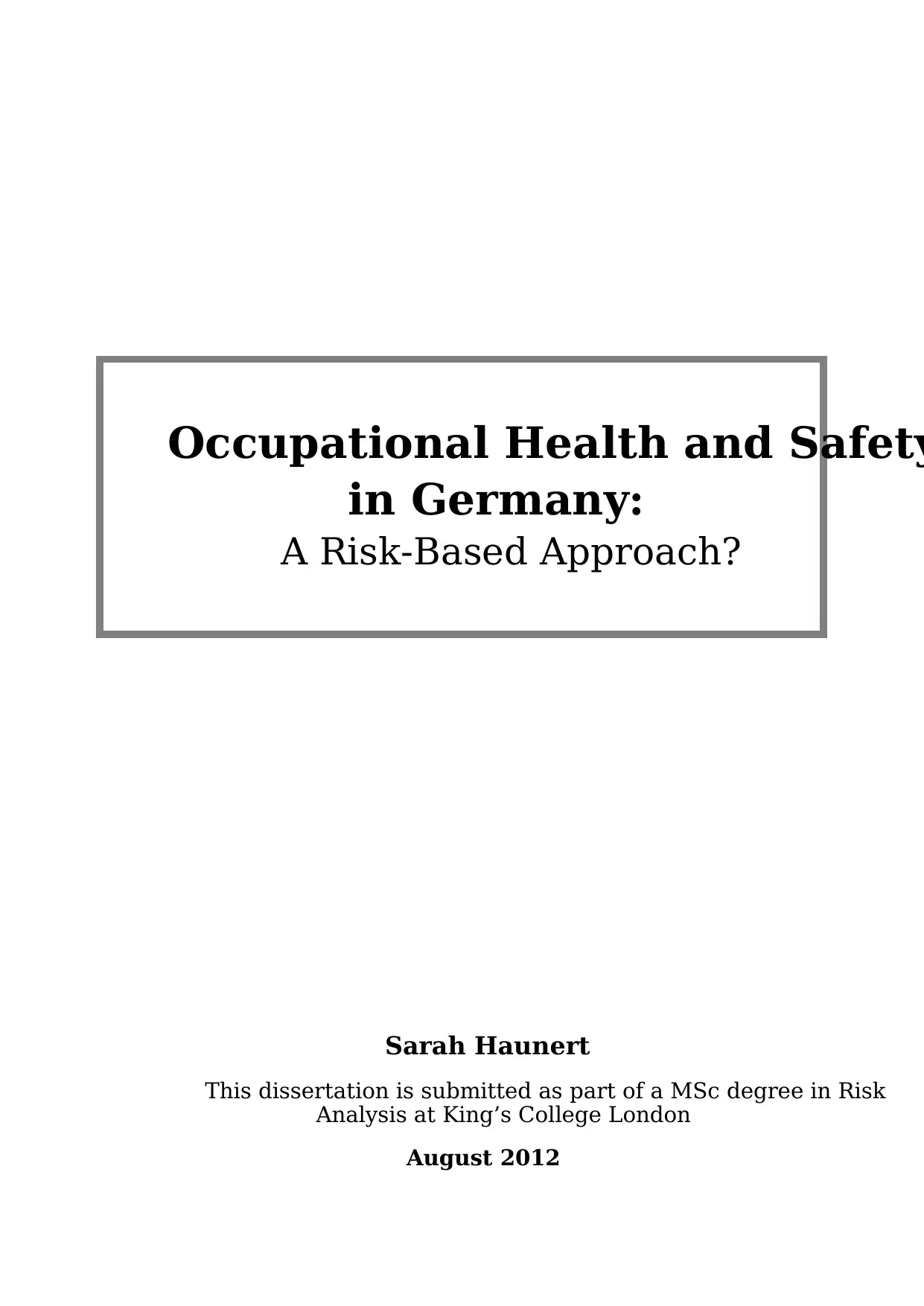
Occupational Health and Safety
in Germany:
A Risk-Based Approach?
Sarah Haunert
This dissertation is submitted as part of a MSc degree in Risk
Analysis at King’s College London
August 2012
in Germany:
A Risk-Based Approach?
Sarah Haunert
This dissertation is submitted as part of a MSc degree in Risk
Analysis at King’s College London
August 2012
Paraphrase This Document
Need a fresh take? Get an instant paraphrase of this document with our AI Paraphraser

2
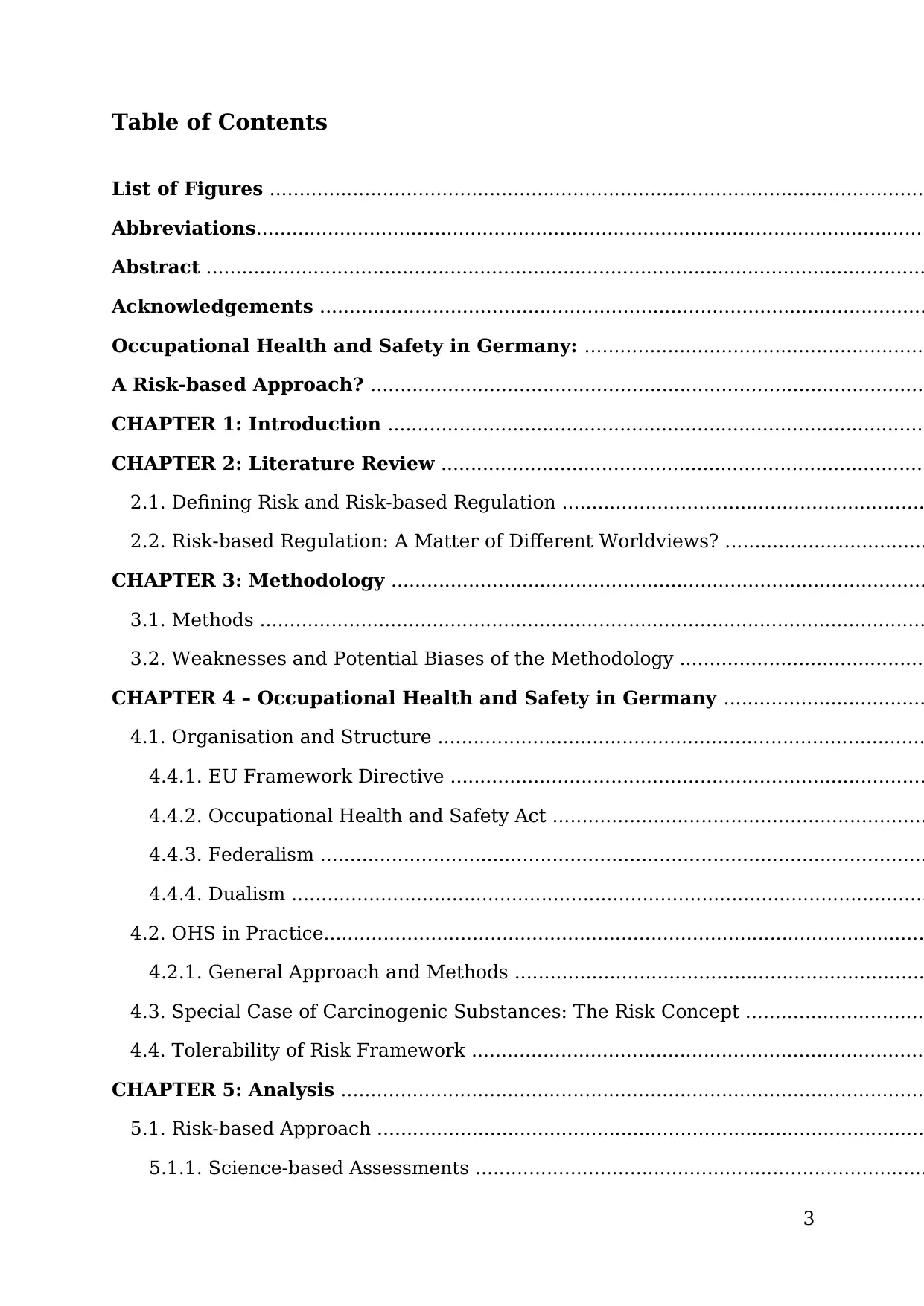
3
Table of Contents
List of Figures ..............................................................................................................
Abbreviations.................................................................................................................
Abstract .........................................................................................................................
Acknowledgements ......................................................................................................
Occupational Health and Safety in Germany: ..........................................................
A Risk-based Approach? .............................................................................................
CHAPTER 1: Introduction ...........................................................................................
CHAPTER 2: Literature Review ..................................................................................
2.1. Defining Risk and Risk-based Regulation .............................................................
2.2. Risk-based Regulation: A Matter of Different Worldviews? ..................................
CHAPTER 3: Methodology ..........................................................................................
3.1. Methods ................................................................................................................
3.2. Weaknesses and Potential Biases of the Methodology ..........................................
CHAPTER 4 – Occupational Health and Safety in Germany ..................................
4.1. Organisation and Structure ..................................................................................
4.4.1. EU Framework Directive ................................................................................
4.4.2. Occupational Health and Safety Act ...............................................................
4.4.3. Federalism ......................................................................................................
4.4.4. Dualism ...........................................................................................................
4.2. OHS in Practice.....................................................................................................
4.2.1. General Approach and Methods .....................................................................
4.3. Special Case of Carcinogenic Substances: The Risk Concept ..............................
4.4. Tolerability of Risk Framework ............................................................................
CHAPTER 5: Analysis ..................................................................................................
5.1. Risk-based Approach ............................................................................................
5.1.1. Science-based Assessments ............................................................................
Table of Contents
List of Figures ..............................................................................................................
Abbreviations.................................................................................................................
Abstract .........................................................................................................................
Acknowledgements ......................................................................................................
Occupational Health and Safety in Germany: ..........................................................
A Risk-based Approach? .............................................................................................
CHAPTER 1: Introduction ...........................................................................................
CHAPTER 2: Literature Review ..................................................................................
2.1. Defining Risk and Risk-based Regulation .............................................................
2.2. Risk-based Regulation: A Matter of Different Worldviews? ..................................
CHAPTER 3: Methodology ..........................................................................................
3.1. Methods ................................................................................................................
3.2. Weaknesses and Potential Biases of the Methodology ..........................................
CHAPTER 4 – Occupational Health and Safety in Germany ..................................
4.1. Organisation and Structure ..................................................................................
4.4.1. EU Framework Directive ................................................................................
4.4.2. Occupational Health and Safety Act ...............................................................
4.4.3. Federalism ......................................................................................................
4.4.4. Dualism ...........................................................................................................
4.2. OHS in Practice.....................................................................................................
4.2.1. General Approach and Methods .....................................................................
4.3. Special Case of Carcinogenic Substances: The Risk Concept ..............................
4.4. Tolerability of Risk Framework ............................................................................
CHAPTER 5: Analysis ..................................................................................................
5.1. Risk-based Approach ............................................................................................
5.1.1. Science-based Assessments ............................................................................
⊘ This is a preview!⊘
Do you want full access?
Subscribe today to unlock all pages.

Trusted by 1+ million students worldwide
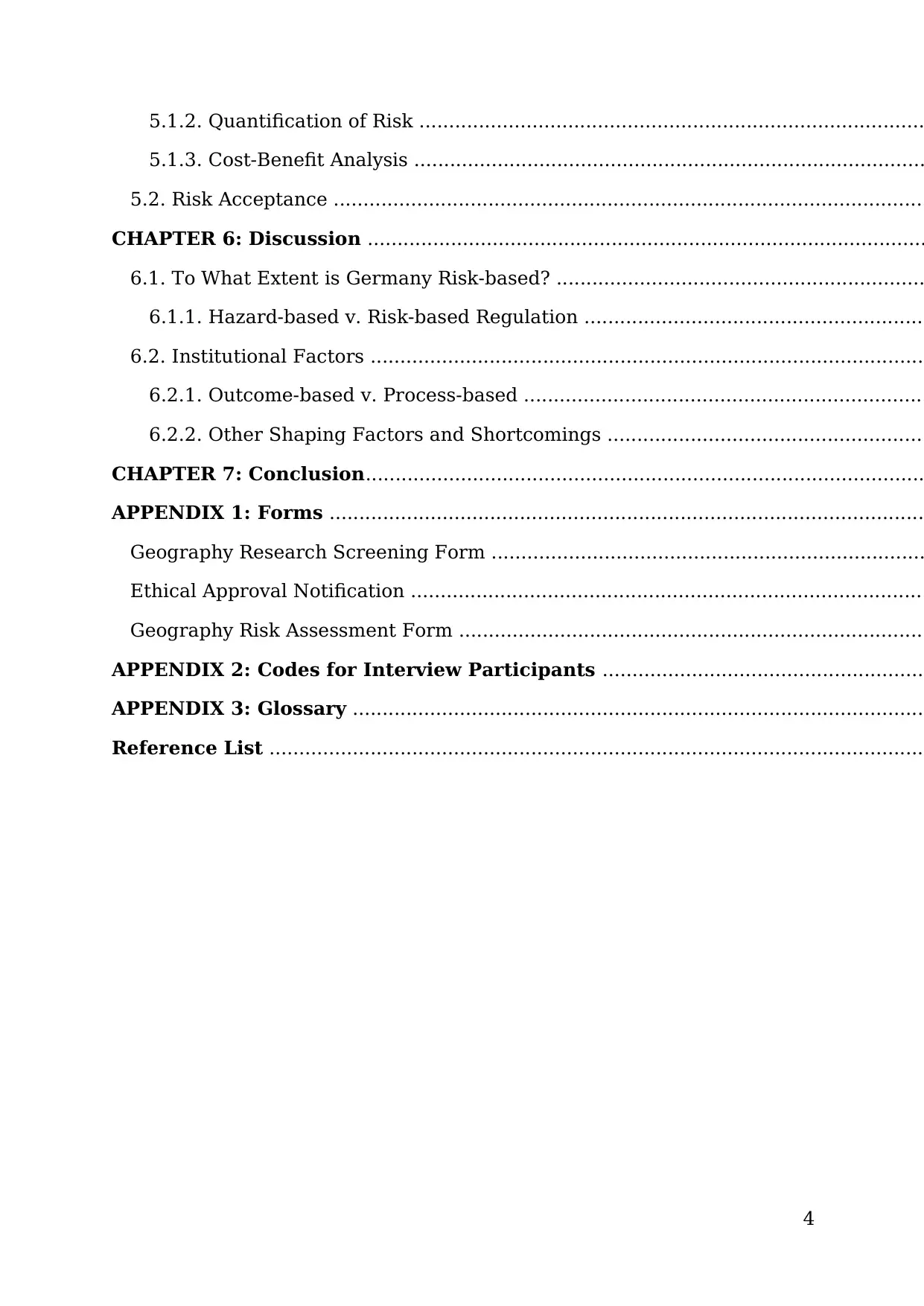
4
5.1.2. Quantification of Risk .....................................................................................
5.1.3. Cost-Benefit Analysis ......................................................................................
5.2. Risk Acceptance ....................................................................................................
CHAPTER 6: Discussion ..............................................................................................
6.1. To What Extent is Germany Risk-based? ..............................................................
6.1.1. Hazard-based v. Risk-based Regulation ..........................................................
6.2. Institutional Factors ..............................................................................................
6.2.1. Outcome-based v. Process-based ....................................................................
6.2.2. Other Shaping Factors and Shortcomings ......................................................
CHAPTER 7: Conclusion..............................................................................................
APPENDIX 1: Forms ....................................................................................................
Geography Research Screening Form .........................................................................
Ethical Approval Notification .......................................................................................
Geography Risk Assessment Form ...............................................................................
APPENDIX 2: Codes for Interview Participants ......................................................
APPENDIX 3: Glossary .................................................................................................
Reference List ..............................................................................................................
5.1.2. Quantification of Risk .....................................................................................
5.1.3. Cost-Benefit Analysis ......................................................................................
5.2. Risk Acceptance ....................................................................................................
CHAPTER 6: Discussion ..............................................................................................
6.1. To What Extent is Germany Risk-based? ..............................................................
6.1.1. Hazard-based v. Risk-based Regulation ..........................................................
6.2. Institutional Factors ..............................................................................................
6.2.1. Outcome-based v. Process-based ....................................................................
6.2.2. Other Shaping Factors and Shortcomings ......................................................
CHAPTER 7: Conclusion..............................................................................................
APPENDIX 1: Forms ....................................................................................................
Geography Research Screening Form .........................................................................
Ethical Approval Notification .......................................................................................
Geography Risk Assessment Form ...............................................................................
APPENDIX 2: Codes for Interview Participants ......................................................
APPENDIX 3: Glossary .................................................................................................
Reference List ..............................................................................................................
Paraphrase This Document
Need a fresh take? Get an instant paraphrase of this document with our AI Paraphraser
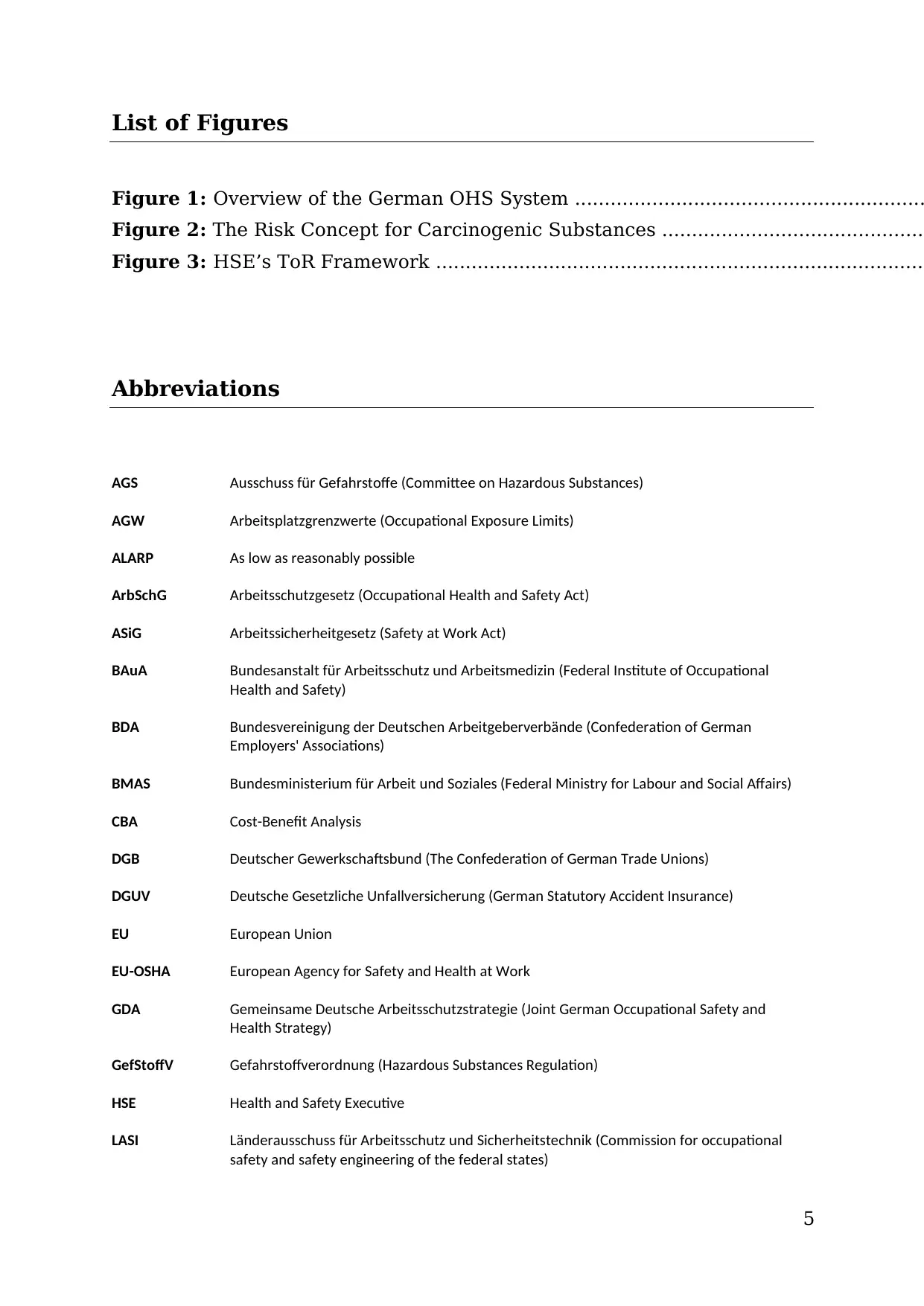
5
List of Figures
Figure 1: Overview of the German OHS System ...........................................................
Figure 2: The Risk Concept for Carcinogenic Substances ............................................
Figure 3: HSE’s ToR Framework ...................................................................................
Abbreviations
AGS Ausschuss für Gefahrstoffe (Committee on Hazardous Substances)
AGW Arbeitsplatzgrenzwerte (Occupational Exposure Limits)
ALARP As low as reasonably possible
ArbSchG Arbeitsschutzgesetz (Occupational Health and Safety Act)
ASiG Arbeitssicherheitgesetz (Safety at Work Act)
BAuA Bundesanstalt für Arbeitsschutz und Arbeitsmedizin (Federal Institute of Occupational
Health and Safety)
BDA Bundesvereinigung der Deutschen Arbeitgeberverbände (Confederation of German
Employers' Associations)
BMAS Bundesministerium für Arbeit und Soziales (Federal Ministry for Labour and Social Affairs)
CBA Cost-Benefit Analysis
DGB Deutscher Gewerkschaftsbund (The Confederation of German Trade Unions)
DGUV Deutsche Gesetzliche Unfallversicherung (German Statutory Accident Insurance)
EU European Union
EU-OSHA European Agency for Safety and Health at Work
GDA Gemeinsame Deutsche Arbeitsschutzstrategie (Joint German Occupational Safety and
Health Strategy)
GefStoffV Gefahrstoffverordnung (Hazardous Substances Regulation)
HSE Health and Safety Executive
LASI Länderausschuss für Arbeitsschutz und Sicherheitstechnik (Commission for occupational
safety and safety engineering of the federal states)
List of Figures
Figure 1: Overview of the German OHS System ...........................................................
Figure 2: The Risk Concept for Carcinogenic Substances ............................................
Figure 3: HSE’s ToR Framework ...................................................................................
Abbreviations
AGS Ausschuss für Gefahrstoffe (Committee on Hazardous Substances)
AGW Arbeitsplatzgrenzwerte (Occupational Exposure Limits)
ALARP As low as reasonably possible
ArbSchG Arbeitsschutzgesetz (Occupational Health and Safety Act)
ASiG Arbeitssicherheitgesetz (Safety at Work Act)
BAuA Bundesanstalt für Arbeitsschutz und Arbeitsmedizin (Federal Institute of Occupational
Health and Safety)
BDA Bundesvereinigung der Deutschen Arbeitgeberverbände (Confederation of German
Employers' Associations)
BMAS Bundesministerium für Arbeit und Soziales (Federal Ministry for Labour and Social Affairs)
CBA Cost-Benefit Analysis
DGB Deutscher Gewerkschaftsbund (The Confederation of German Trade Unions)
DGUV Deutsche Gesetzliche Unfallversicherung (German Statutory Accident Insurance)
EU European Union
EU-OSHA European Agency for Safety and Health at Work
GDA Gemeinsame Deutsche Arbeitsschutzstrategie (Joint German Occupational Safety and
Health Strategy)
GefStoffV Gefahrstoffverordnung (Hazardous Substances Regulation)
HSE Health and Safety Executive
LASI Länderausschuss für Arbeitsschutz und Sicherheitstechnik (Commission for occupational
safety and safety engineering of the federal states)
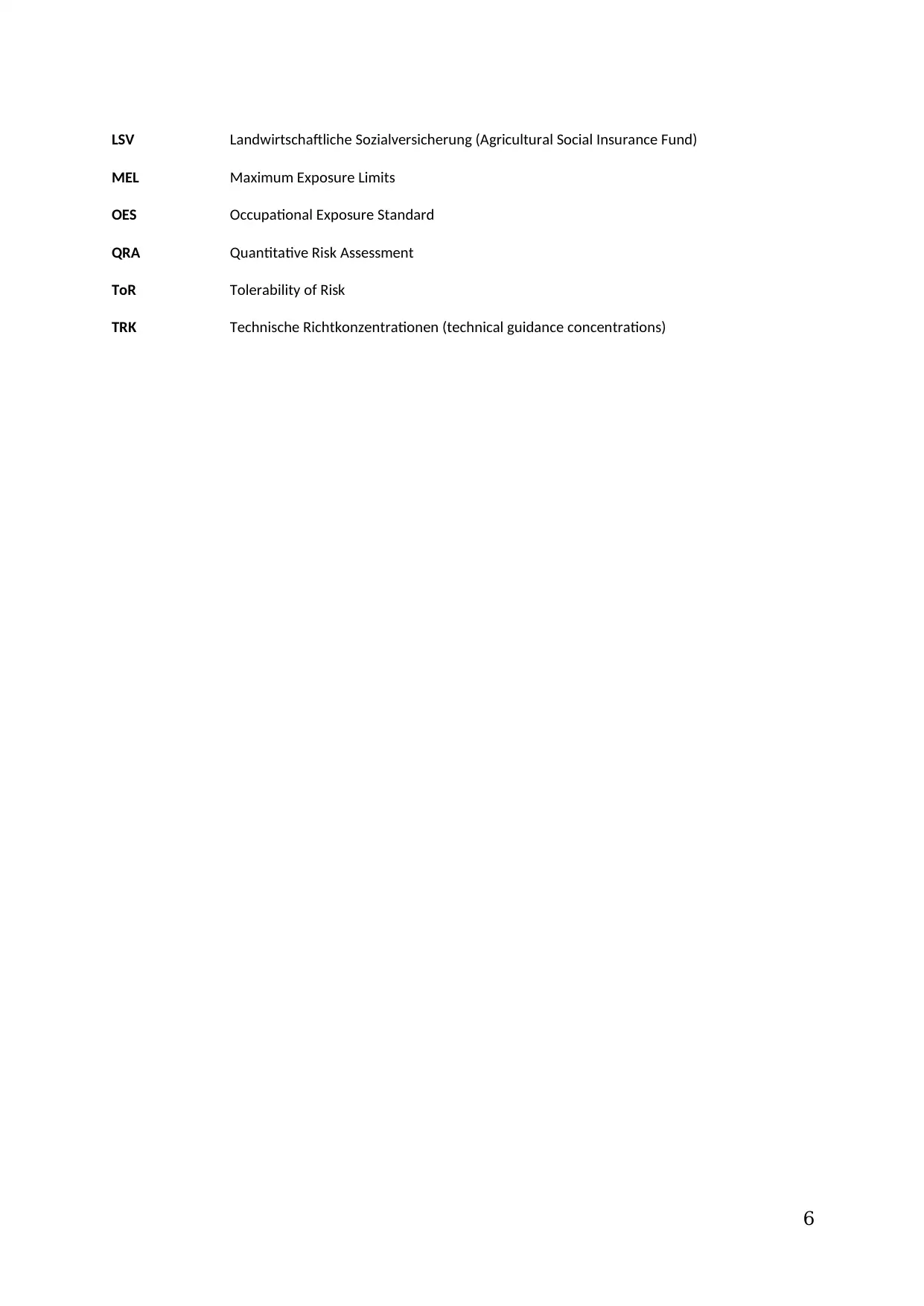
6
LSV Landwirtschaftliche Sozialversicherung (Agricultural Social Insurance Fund)
MEL Maximum Exposure Limits
OES Occupational Exposure Standard
QRA Quantitative Risk Assessment
ToR Tolerability of Risk
TRK Technische Richtkonzentrationen (technical guidance concentrations)
LSV Landwirtschaftliche Sozialversicherung (Agricultural Social Insurance Fund)
MEL Maximum Exposure Limits
OES Occupational Exposure Standard
QRA Quantitative Risk Assessment
ToR Tolerability of Risk
TRK Technische Richtkonzentrationen (technical guidance concentrations)
⊘ This is a preview!⊘
Do you want full access?
Subscribe today to unlock all pages.

Trusted by 1+ million students worldwide
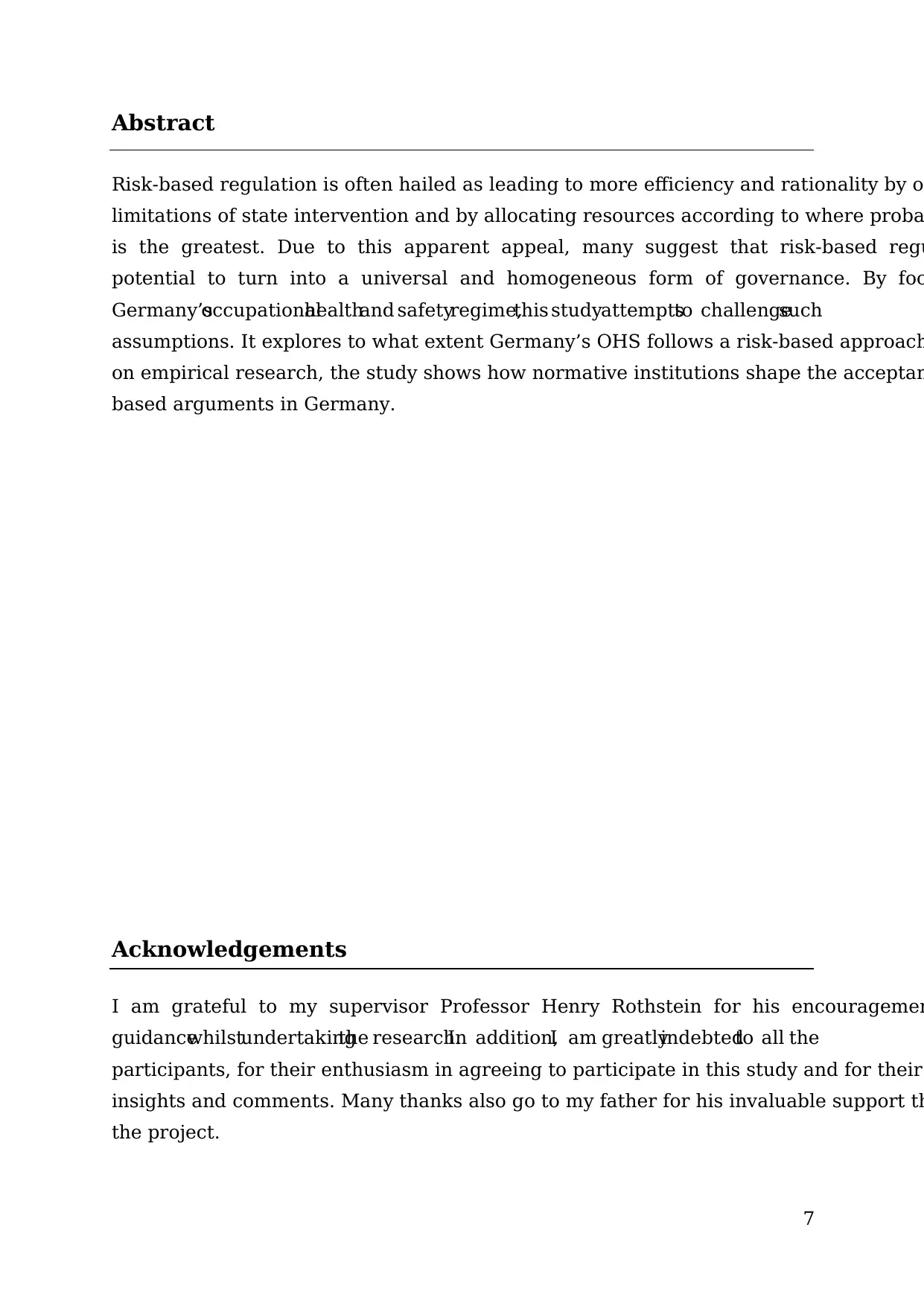
7
Abstract
Risk-based regulation is often hailed as leading to more efficiency and rationality by o
limitations of state intervention and by allocating resources according to where proba
is the greatest. Due to this apparent appeal, many suggest that risk-based regu
potential to turn into a universal and homogeneous form of governance. By foc
Germany’soccupationalhealthand safetyregime,this studyattemptsto challengesuch
assumptions. It explores to what extent Germany’s OHS follows a risk-based approach
on empirical research, the study shows how normative institutions shape the acceptan
based arguments in Germany.
Acknowledgements
I am grateful to my supervisor Professor Henry Rothstein for his encouragemen
guidancewhilstundertakingthe research.In addition,I am greatlyindebtedto all the
participants, for their enthusiasm in agreeing to participate in this study and for their
insights and comments. Many thanks also go to my father for his invaluable support th
the project.
Abstract
Risk-based regulation is often hailed as leading to more efficiency and rationality by o
limitations of state intervention and by allocating resources according to where proba
is the greatest. Due to this apparent appeal, many suggest that risk-based regu
potential to turn into a universal and homogeneous form of governance. By foc
Germany’soccupationalhealthand safetyregime,this studyattemptsto challengesuch
assumptions. It explores to what extent Germany’s OHS follows a risk-based approach
on empirical research, the study shows how normative institutions shape the acceptan
based arguments in Germany.
Acknowledgements
I am grateful to my supervisor Professor Henry Rothstein for his encouragemen
guidancewhilstundertakingthe research.In addition,I am greatlyindebtedto all the
participants, for their enthusiasm in agreeing to participate in this study and for their
insights and comments. Many thanks also go to my father for his invaluable support th
the project.
Paraphrase This Document
Need a fresh take? Get an instant paraphrase of this document with our AI Paraphraser
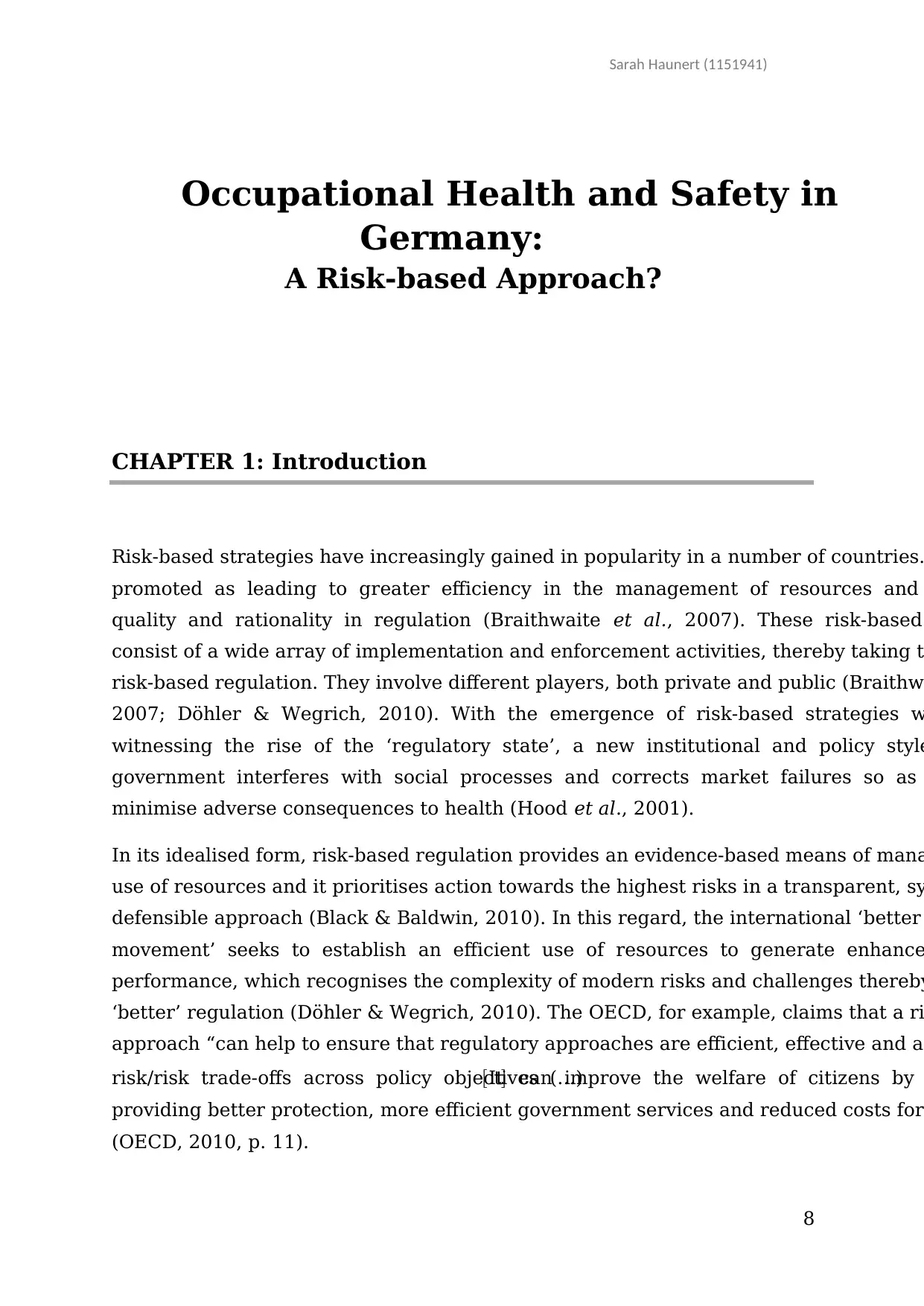
Sarah Haunert (1151941)
8
Occupational Health and Safety in
Germany:
A Risk-based Approach?
CHAPTER 1: Introduction
Risk-based strategies have increasingly gained in popularity in a number of countries.
promoted as leading to greater efficiency in the management of resources and
quality and rationality in regulation (Braithwaite et al., 2007). These risk-based
consist of a wide array of implementation and enforcement activities, thereby taking t
risk-based regulation. They involve different players, both private and public (Braithw
2007; Döhler & Wegrich, 2010). With the emergence of risk-based strategies w
witnessing the rise of the ‘regulatory state’, a new institutional and policy style
government interferes with social processes and corrects market failures so as
minimise adverse consequences to health (Hood et al., 2001).
In its idealised form, risk-based regulation provides an evidence-based means of mana
use of resources and it prioritises action towards the highest risks in a transparent, sy
defensible approach (Black & Baldwin, 2010). In this regard, the international ‘better
movement’ seeks to establish an efficient use of resources to generate enhance
performance, which recognises the complexity of modern risks and challenges thereby
‘better’ regulation (Döhler & Wegrich, 2010). The OECD, for example, claims that a ri
approach “can help to ensure that regulatory approaches are efficient, effective and a
risk/risk trade-offs across policy objectives (…)[It] can improve the welfare of citizens by
providing better protection, more efficient government services and reduced costs for
(OECD, 2010, p. 11).
8
Occupational Health and Safety in
Germany:
A Risk-based Approach?
CHAPTER 1: Introduction
Risk-based strategies have increasingly gained in popularity in a number of countries.
promoted as leading to greater efficiency in the management of resources and
quality and rationality in regulation (Braithwaite et al., 2007). These risk-based
consist of a wide array of implementation and enforcement activities, thereby taking t
risk-based regulation. They involve different players, both private and public (Braithw
2007; Döhler & Wegrich, 2010). With the emergence of risk-based strategies w
witnessing the rise of the ‘regulatory state’, a new institutional and policy style
government interferes with social processes and corrects market failures so as
minimise adverse consequences to health (Hood et al., 2001).
In its idealised form, risk-based regulation provides an evidence-based means of mana
use of resources and it prioritises action towards the highest risks in a transparent, sy
defensible approach (Black & Baldwin, 2010). In this regard, the international ‘better
movement’ seeks to establish an efficient use of resources to generate enhance
performance, which recognises the complexity of modern risks and challenges thereby
‘better’ regulation (Döhler & Wegrich, 2010). The OECD, for example, claims that a ri
approach “can help to ensure that regulatory approaches are efficient, effective and a
risk/risk trade-offs across policy objectives (…)[It] can improve the welfare of citizens by
providing better protection, more efficient government services and reduced costs for
(OECD, 2010, p. 11).
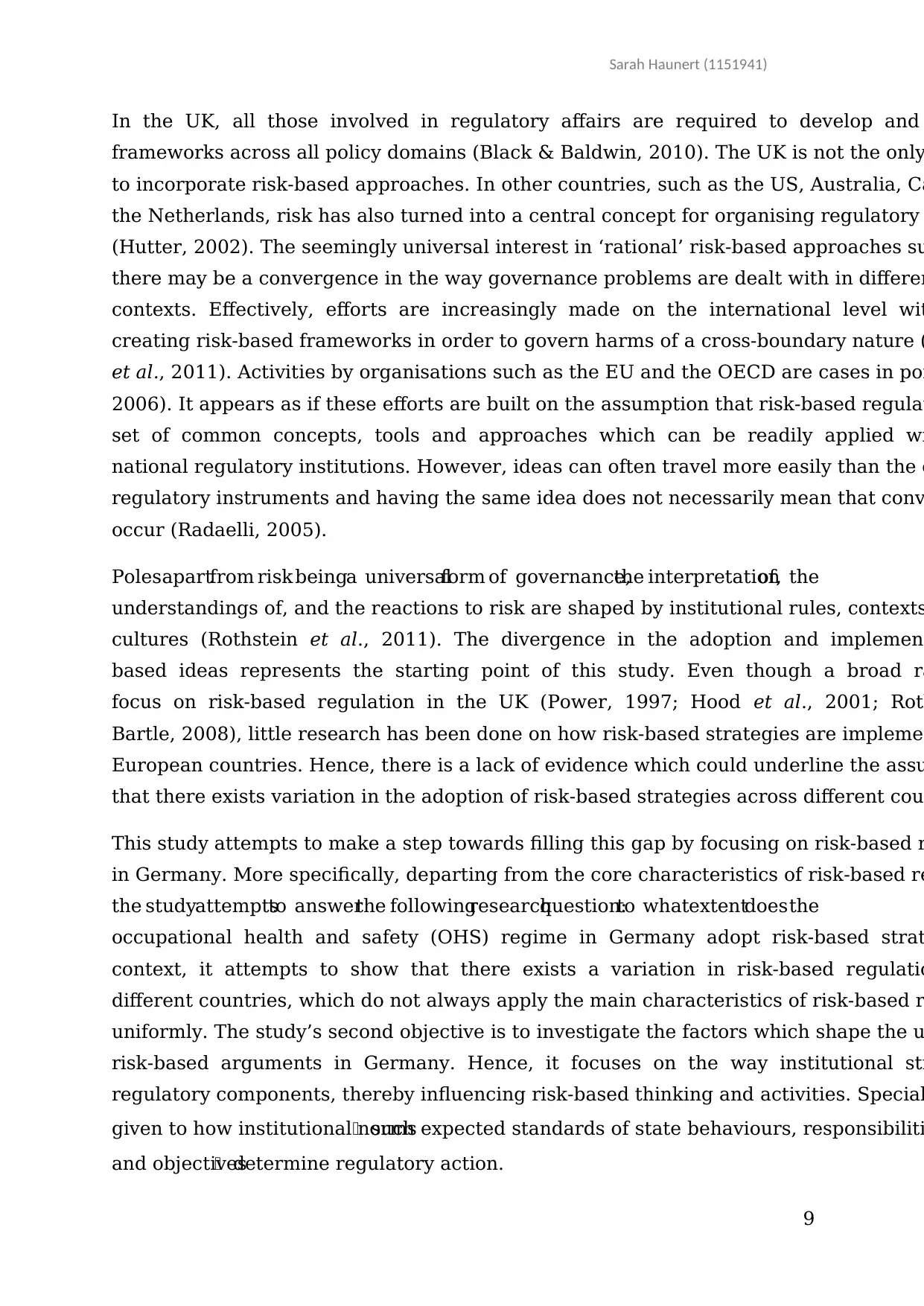
Sarah Haunert (1151941)
9
In the UK, all those involved in regulatory affairs are required to develop and
frameworks across all policy domains (Black & Baldwin, 2010). The UK is not the only
to incorporate risk-based approaches. In other countries, such as the US, Australia, Ca
the Netherlands, risk has also turned into a central concept for organising regulatory
(Hutter, 2002). The seemingly universal interest in ‘rational’ risk-based approaches su
there may be a convergence in the way governance problems are dealt with in differen
contexts. Effectively, efforts are increasingly made on the international level wit
creating risk-based frameworks in order to govern harms of a cross-boundary nature (
et al., 2011). Activities by organisations such as the EU and the OECD are cases in poi
2006). It appears as if these efforts are built on the assumption that risk-based regulat
set of common concepts, tools and approaches which can be readily applied wi
national regulatory institutions. However, ideas can often travel more easily than the c
regulatory instruments and having the same idea does not necessarily mean that conv
occur (Radaelli, 2005).
Polesapartfrom risk beinga universalform of governance,the interpretationof, the
understandings of, and the reactions to risk are shaped by institutional rules, contexts
cultures (Rothstein et al., 2011). The divergence in the adoption and implemen
based ideas represents the starting point of this study. Even though a broad ra
focus on risk-based regulation in the UK (Power, 1997; Hood et al., 2001; Roth
Bartle, 2008), little research has been done on how risk-based strategies are implemen
European countries. Hence, there is a lack of evidence which could underline the assu
that there exists variation in the adoption of risk-based strategies across different cou
This study attempts to make a step towards filling this gap by focusing on risk-based r
in Germany. More specifically, departing from the core characteristics of risk-based re
the studyattemptsto answerthe followingresearchquestion:to whatextentdoes the
occupational health and safety (OHS) regime in Germany adopt risk-based strat
context, it attempts to show that there exists a variation in risk-based regulatio
different countries, which do not always apply the main characteristics of risk-based r
uniformly. The study’s second objective is to investigate the factors which shape the u
risk-based arguments in Germany. Hence, it focuses on the way institutional str
regulatory components, thereby influencing risk-based thinking and activities. Special
given to how institutional norms such expected standards of state behaviours, responsibiliti
and objectives determine regulatory action.
9
In the UK, all those involved in regulatory affairs are required to develop and
frameworks across all policy domains (Black & Baldwin, 2010). The UK is not the only
to incorporate risk-based approaches. In other countries, such as the US, Australia, Ca
the Netherlands, risk has also turned into a central concept for organising regulatory
(Hutter, 2002). The seemingly universal interest in ‘rational’ risk-based approaches su
there may be a convergence in the way governance problems are dealt with in differen
contexts. Effectively, efforts are increasingly made on the international level wit
creating risk-based frameworks in order to govern harms of a cross-boundary nature (
et al., 2011). Activities by organisations such as the EU and the OECD are cases in poi
2006). It appears as if these efforts are built on the assumption that risk-based regulat
set of common concepts, tools and approaches which can be readily applied wi
national regulatory institutions. However, ideas can often travel more easily than the c
regulatory instruments and having the same idea does not necessarily mean that conv
occur (Radaelli, 2005).
Polesapartfrom risk beinga universalform of governance,the interpretationof, the
understandings of, and the reactions to risk are shaped by institutional rules, contexts
cultures (Rothstein et al., 2011). The divergence in the adoption and implemen
based ideas represents the starting point of this study. Even though a broad ra
focus on risk-based regulation in the UK (Power, 1997; Hood et al., 2001; Roth
Bartle, 2008), little research has been done on how risk-based strategies are implemen
European countries. Hence, there is a lack of evidence which could underline the assu
that there exists variation in the adoption of risk-based strategies across different cou
This study attempts to make a step towards filling this gap by focusing on risk-based r
in Germany. More specifically, departing from the core characteristics of risk-based re
the studyattemptsto answerthe followingresearchquestion:to whatextentdoes the
occupational health and safety (OHS) regime in Germany adopt risk-based strat
context, it attempts to show that there exists a variation in risk-based regulatio
different countries, which do not always apply the main characteristics of risk-based r
uniformly. The study’s second objective is to investigate the factors which shape the u
risk-based arguments in Germany. Hence, it focuses on the way institutional str
regulatory components, thereby influencing risk-based thinking and activities. Special
given to how institutional norms such expected standards of state behaviours, responsibiliti
and objectives determine regulatory action.
⊘ This is a preview!⊘
Do you want full access?
Subscribe today to unlock all pages.

Trusted by 1+ million students worldwide
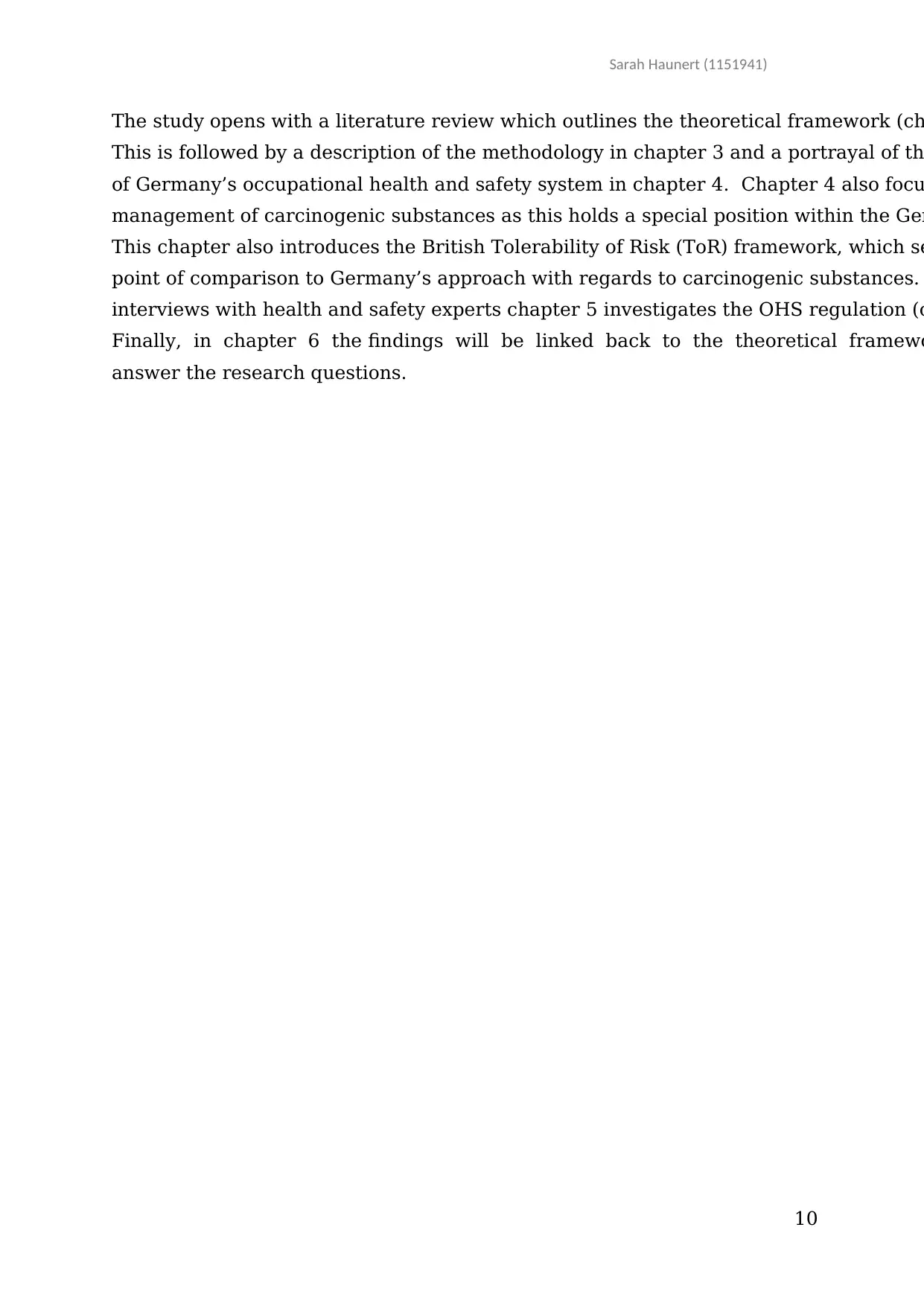
Sarah Haunert (1151941)
10
The study opens with a literature review which outlines the theoretical framework (ch
This is followed by a description of the methodology in chapter 3 and a portrayal of th
of Germany’s occupational health and safety system in chapter 4. Chapter 4 also focu
management of carcinogenic substances as this holds a special position within the Ger
This chapter also introduces the British Tolerability of Risk (ToR) framework, which se
point of comparison to Germany’s approach with regards to carcinogenic substances.
interviews with health and safety experts chapter 5 investigates the OHS regulation (c
Finally, in chapter 6 the findings will be linked back to the theoretical framewo
answer the research questions.
10
The study opens with a literature review which outlines the theoretical framework (ch
This is followed by a description of the methodology in chapter 3 and a portrayal of th
of Germany’s occupational health and safety system in chapter 4. Chapter 4 also focu
management of carcinogenic substances as this holds a special position within the Ger
This chapter also introduces the British Tolerability of Risk (ToR) framework, which se
point of comparison to Germany’s approach with regards to carcinogenic substances.
interviews with health and safety experts chapter 5 investigates the OHS regulation (c
Finally, in chapter 6 the findings will be linked back to the theoretical framewo
answer the research questions.
Paraphrase This Document
Need a fresh take? Get an instant paraphrase of this document with our AI Paraphraser
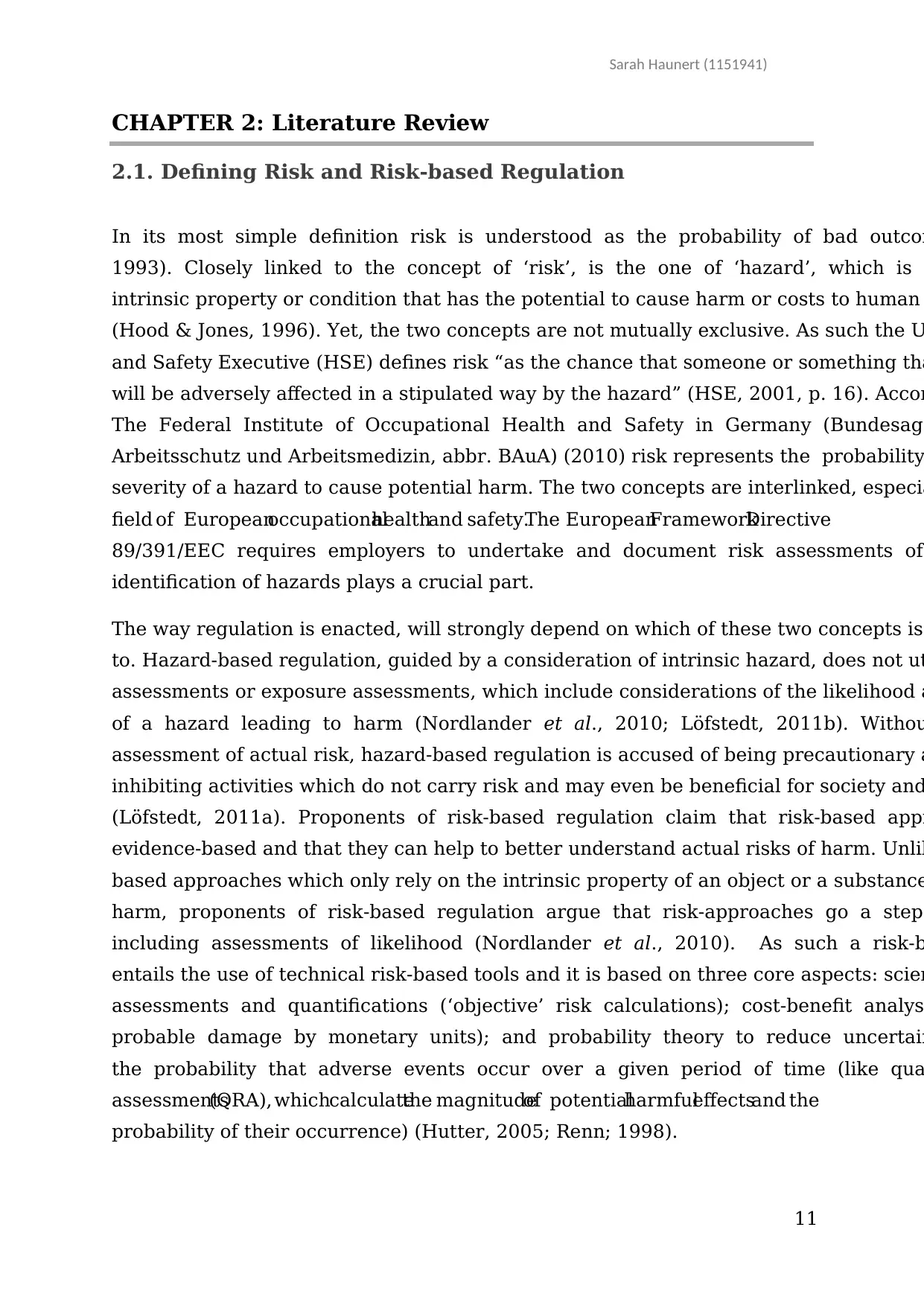
Sarah Haunert (1151941)
11
CHAPTER 2: Literature Review
2.1. Defining Risk and Risk-based Regulation
In its most simple definition risk is understood as the probability of bad outcom
1993). Closely linked to the concept of ‘risk’, is the one of ‘hazard’, which is
intrinsic property or condition that has the potential to cause harm or costs to human
(Hood & Jones, 1996). Yet, the two concepts are not mutually exclusive. As such the U
and Safety Executive (HSE) defines risk “as the chance that someone or something tha
will be adversely affected in a stipulated way by the hazard” (HSE, 2001, p. 16). Accor
The Federal Institute of Occupational Health and Safety in Germany (Bundesage
Arbeitsschutz und Arbeitsmedizin, abbr. BAuA) (2010) risk represents the probability
severity of a hazard to cause potential harm. The two concepts are interlinked, especia
field of Europeanoccupationalhealthand safety.The EuropeanFrameworkDirective
89/391/EEC requires employers to undertake and document risk assessments of
identification of hazards plays a crucial part.
The way regulation is enacted, will strongly depend on which of these two concepts is
to. Hazard-based regulation, guided by a consideration of intrinsic hazard, does not ut
assessments or exposure assessments, which include considerations of the likelihood a
of a hazard leading to harm (Nordlander et al., 2010; Löfstedt, 2011b). Withou
assessment of actual risk, hazard-based regulation is accused of being precautionary a
inhibiting activities which do not carry risk and may even be beneficial for society and
(Löfstedt, 2011a). Proponents of risk-based regulation claim that risk-based appr
evidence-based and that they can help to better understand actual risks of harm. Unlik
based approaches which only rely on the intrinsic property of an object or a substance
harm, proponents of risk-based regulation argue that risk-approaches go a step
including assessments of likelihood (Nordlander et al., 2010). As such a risk-b
entails the use of technical risk-based tools and it is based on three core aspects: scien
assessments and quantifications (‘objective’ risk calculations); cost-benefit analys
probable damage by monetary units); and probability theory to reduce uncertain
the probability that adverse events occur over a given period of time (like qua
assessments(QRA), whichcalculatethe magnitudeof potentialharmfuleffectsand the
probability of their occurrence) (Hutter, 2005; Renn; 1998).
11
CHAPTER 2: Literature Review
2.1. Defining Risk and Risk-based Regulation
In its most simple definition risk is understood as the probability of bad outcom
1993). Closely linked to the concept of ‘risk’, is the one of ‘hazard’, which is
intrinsic property or condition that has the potential to cause harm or costs to human
(Hood & Jones, 1996). Yet, the two concepts are not mutually exclusive. As such the U
and Safety Executive (HSE) defines risk “as the chance that someone or something tha
will be adversely affected in a stipulated way by the hazard” (HSE, 2001, p. 16). Accor
The Federal Institute of Occupational Health and Safety in Germany (Bundesage
Arbeitsschutz und Arbeitsmedizin, abbr. BAuA) (2010) risk represents the probability
severity of a hazard to cause potential harm. The two concepts are interlinked, especia
field of Europeanoccupationalhealthand safety.The EuropeanFrameworkDirective
89/391/EEC requires employers to undertake and document risk assessments of
identification of hazards plays a crucial part.
The way regulation is enacted, will strongly depend on which of these two concepts is
to. Hazard-based regulation, guided by a consideration of intrinsic hazard, does not ut
assessments or exposure assessments, which include considerations of the likelihood a
of a hazard leading to harm (Nordlander et al., 2010; Löfstedt, 2011b). Withou
assessment of actual risk, hazard-based regulation is accused of being precautionary a
inhibiting activities which do not carry risk and may even be beneficial for society and
(Löfstedt, 2011a). Proponents of risk-based regulation claim that risk-based appr
evidence-based and that they can help to better understand actual risks of harm. Unlik
based approaches which only rely on the intrinsic property of an object or a substance
harm, proponents of risk-based regulation argue that risk-approaches go a step
including assessments of likelihood (Nordlander et al., 2010). As such a risk-b
entails the use of technical risk-based tools and it is based on three core aspects: scien
assessments and quantifications (‘objective’ risk calculations); cost-benefit analys
probable damage by monetary units); and probability theory to reduce uncertain
the probability that adverse events occur over a given period of time (like qua
assessments(QRA), whichcalculatethe magnitudeof potentialharmfuleffectsand the
probability of their occurrence) (Hutter, 2005; Renn; 1998).
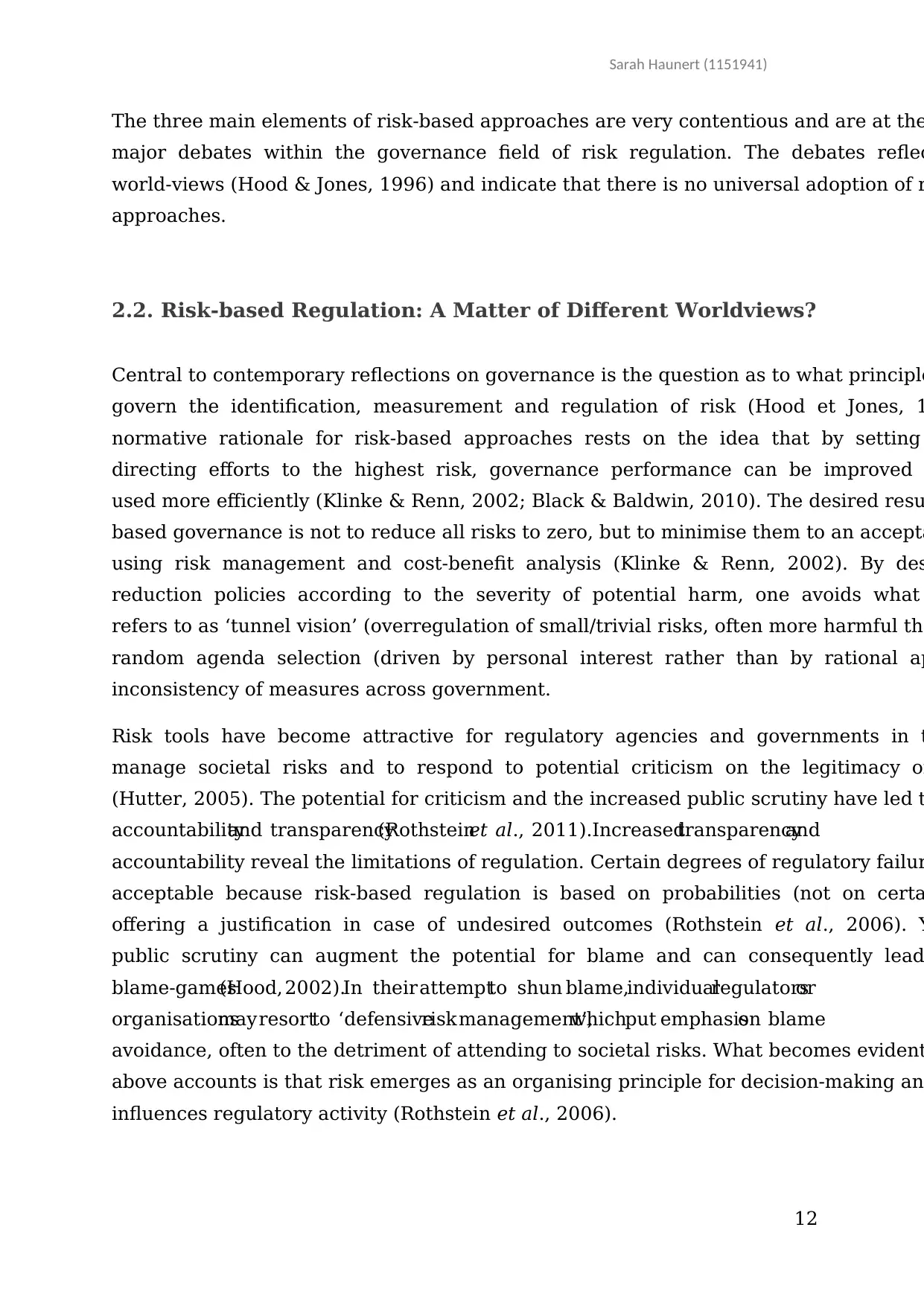
Sarah Haunert (1151941)
12
The three main elements of risk-based approaches are very contentious and are at the
major debates within the governance field of risk regulation. The debates reflec
world-views (Hood & Jones, 1996) and indicate that there is no universal adoption of r
approaches.
2.2. Risk-based Regulation: A Matter of Different Worldviews?
Central to contemporary reflections on governance is the question as to what principle
govern the identification, measurement and regulation of risk (Hood et Jones, 1
normative rationale for risk-based approaches rests on the idea that by setting
directing efforts to the highest risk, governance performance can be improved
used more efficiently (Klinke & Renn, 2002; Black & Baldwin, 2010). The desired resu
based governance is not to reduce all risks to zero, but to minimise them to an accepta
using risk management and cost-benefit analysis (Klinke & Renn, 2002). By des
reduction policies according to the severity of potential harm, one avoids what
refers to as ‘tunnel vision’ (overregulation of small/trivial risks, often more harmful tha
random agenda selection (driven by personal interest rather than by rational ap
inconsistency of measures across government.
Risk tools have become attractive for regulatory agencies and governments in t
manage societal risks and to respond to potential criticism on the legitimacy of
(Hutter, 2005). The potential for criticism and the increased public scrutiny have led t
accountabilityand transparency(Rothsteinet al., 2011).Increasedtransparencyand
accountability reveal the limitations of regulation. Certain degrees of regulatory failur
acceptable because risk-based regulation is based on probabilities (not on certa
offering a justification in case of undesired outcomes (Rothstein et al., 2006). Y
public scrutiny can augment the potential for blame and can consequently lead
blame-games(Hood, 2002).In their attemptto shun blame,individualregulatorsor
organisationsmay resortto ‘defensiverisk management’,whichput emphasison blame
avoidance, often to the detriment of attending to societal risks. What becomes evident
above accounts is that risk emerges as an organising principle for decision-making an
influences regulatory activity (Rothstein et al., 2006).
12
The three main elements of risk-based approaches are very contentious and are at the
major debates within the governance field of risk regulation. The debates reflec
world-views (Hood & Jones, 1996) and indicate that there is no universal adoption of r
approaches.
2.2. Risk-based Regulation: A Matter of Different Worldviews?
Central to contemporary reflections on governance is the question as to what principle
govern the identification, measurement and regulation of risk (Hood et Jones, 1
normative rationale for risk-based approaches rests on the idea that by setting
directing efforts to the highest risk, governance performance can be improved
used more efficiently (Klinke & Renn, 2002; Black & Baldwin, 2010). The desired resu
based governance is not to reduce all risks to zero, but to minimise them to an accepta
using risk management and cost-benefit analysis (Klinke & Renn, 2002). By des
reduction policies according to the severity of potential harm, one avoids what
refers to as ‘tunnel vision’ (overregulation of small/trivial risks, often more harmful tha
random agenda selection (driven by personal interest rather than by rational ap
inconsistency of measures across government.
Risk tools have become attractive for regulatory agencies and governments in t
manage societal risks and to respond to potential criticism on the legitimacy of
(Hutter, 2005). The potential for criticism and the increased public scrutiny have led t
accountabilityand transparency(Rothsteinet al., 2011).Increasedtransparencyand
accountability reveal the limitations of regulation. Certain degrees of regulatory failur
acceptable because risk-based regulation is based on probabilities (not on certa
offering a justification in case of undesired outcomes (Rothstein et al., 2006). Y
public scrutiny can augment the potential for blame and can consequently lead
blame-games(Hood, 2002).In their attemptto shun blame,individualregulatorsor
organisationsmay resortto ‘defensiverisk management’,whichput emphasison blame
avoidance, often to the detriment of attending to societal risks. What becomes evident
above accounts is that risk emerges as an organising principle for decision-making an
influences regulatory activity (Rothstein et al., 2006).
⊘ This is a preview!⊘
Do you want full access?
Subscribe today to unlock all pages.

Trusted by 1+ million students worldwide
1 out of 54
Your All-in-One AI-Powered Toolkit for Academic Success.
+13062052269
info@desklib.com
Available 24*7 on WhatsApp / Email
![[object Object]](/_next/static/media/star-bottom.7253800d.svg)
Unlock your academic potential
Copyright © 2020–2025 A2Z Services. All Rights Reserved. Developed and managed by ZUCOL.